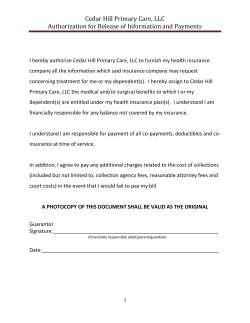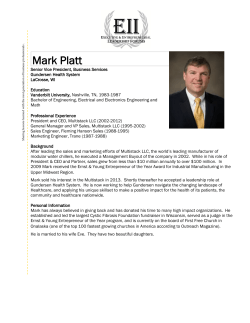
How PURPA is Driving Utility Scale Solar in North Carolina
How PURPA is driving utility scale solar in North Carolina By QF Solutions April 7, 2015 Overview 1. Utility Scale Solar in North Carolina 2. PURPA 101 – What is PURPA? 3. How Avoided Costs are calculated 4. PURPA’s Evolution – 1980 to EPAct’05 5. PURPA Risks and Opportunities going forward QF SOLUTIONS LLC 4/7/2015 2 HXOap Solar One LLC ▪ The Birth of a Solar Farm in Halifax County, NC ▪ See video of the project at: http://youtube/QmHzP-i-mm4 QF SOLUTIONS LLC 4/7/2015 3 I. Utility Scale Solar in North Carolina ▪ Solar Photovoltaic (PV) Systems ▪ 2 MW or more ▪ Sell all output to Utility ▪ Approximately 5 acres/MW ▪ Fixed tilt, some single-axis tracking HNXOap Solar One LLC, Roanoke Rapids, NC 20 MW AC, 15 year Power Purchase Agreement with Dominion North Carolina Power Developed by Geenex and ET Solar Purchased by Duke Energy Renewables QF SOLUTIONS LLC 4/7/2015 4 # 4 NC rank is driven by Utility Scale Solar HTTP://WWW.SEIA.ORG/RESEARCH-RESOURCES/SOLAR-INDUSTRY-DATA 4/7/2015 5 Why is utility scale solar booming in NC? ▪ Renewable Energy and Energy Efficiency Portfolio Standard (12.5% by 2021) ▪ NC Business and Energy Tax Credits – Up to 35% invested capital tax credit ▪ Federal Business Energy Investment Tax Credit – Up to 30% tax credit for invested capital ▪ 80% property tax abatement ▪ Good solar resources ▪ Minimal barrier to entry ▪ Decreasing cost of solar ▪ NC’s implementation of PURPA QF SOLUTIONS LLC 4/7/2015 6 II. What is PURPA 101 – What is PURPA ▪ Public Utilities Regulatory Policies Act of 1978 (Pub. L. No. 95-617, 92 Stat. 3117) ▪ Part of the National Energy Act (five pieces of major legislation) ▪ Congress’s primary policy objectives: • Reduce demand on fossil fuels • Overcome utilities’ reluctance to purchase power from and sell power to non-utility generators (NUGs) QF SOLUTIONS LLC 4/7/2015 7 North Carolina G.S. 62-156 (1979) ▪ NC enacted G.S. 62-156: By March 1, 1981 rules need to be established to encourage and enhance the economic viability of small power producers. ▪ NCUC subsequently ordered biennial filings of Qualified Facility (QF) tariffs with public comment periods. • Standard Rates and Contracts up to 5 MW; option of two year variable or fixed rate tariff. Five, ten and fifteen year terms are options for the fixed rate tariff. • Negotiated contracts between 5 MW and 80 MW • QFs that are not eligible for the standard long-term levelized rates have the following three options if the utility has a Commission-recognized active solicitation underway: 1) participate in the utility’s competitive bidding process, 2) negotiate a contract with the utility or 3) sell energy at the utility’s Commission-established variable energy rate. QF SOLUTIONS LLC 4/7/2015 8 PURPA matters most in regulated states with no regional transmission organizations…(minimal competition) ISOs/RTOs QF SOLUTIONS LLC 4/7/2015 9 PURPA Created a New Class of Generator - Qualified Facility (QF) Cogeneration Facility OR Small Power Production Facility AND Not owned by persons primarily engaged in the generation or sell of electric power* QF SOLUTIONS LLC * Repealed by EPAct ‘05 4/7/2015 10 Cogeneration Facility ▪ A facility which produces electric energy and steam or forms of useful energy (such as heat) which are used for industrial, commercial, heating, or cooling purposes. ▪ Policy: Cogeneration facilities use significantly less fuel to produce electricity and steam (or other energy) than would be needed to produce the two separately. ▪ No maximum size for PURPA eligibility ▪ Specific requirements at 18 CFR §§ 292.202-205 QF SOLUTIONS LLC 4/7/2015 11 Small Power Production Facility ▪ A facility which uses biomass, waste, or renewable resources, including wind, solar energy and water, to produce electric power; which, together with an other facility located at the same site, has capacity < 80 MW. ▪ Policy: Reliance on these sources of energy can reduce the need to consume fossil fuels to generate electric power. ▪ Specific requirements at 18 CFR §§ 292.202-204 QF SOLUTIONS LLC 4/7/2015 12 To Whom does PURPA apply? ▪ The term “electric utility” means a person or Federal or State agency (including an entity described in section 210 (f) of this title) that sell electric energy. ▪ PURPA must-buy obligation applies to Investor Owned Utilities (IOUs), Municipal Owned Utilities (MOUs), Co-Ops, etc. [unless FERC grants a waiver or excuses the utility under § 210 (m)]. QF SOLUTIONS LLC 4/7/2015 13 Purchase Price Defined PURPA § 210 (b) FERC Implementation (292.101(b)(6)): Rates: (1) Shall be just and reasonable to the electric consumers of the electric utility and in the public interest, and (2) Shall not discriminate against co-generators or small power producers. Rates also must not exceed the incremental cost to the electric utility of alternative electric energy. Rates must equal the utility’s “full avoided cost”; “the incremental costs to the electric utility of electric energy or capacity or both which, but for the purchase from the QF or QFs, such utility would generate itself or purchase from another source.” FERC requires utilities to pay the full avoided cost. PURPA is not intended to subsidize QFs. If the purchase price of electricity exceeds the avoided cost, the difference can be considered a renewable energy attribute. Renewable energy attributes are sold as Renewable Energy Credits (RECs). QF SOLUTIONS LLC 4/7/2015 14 III. How Avoided Cost Rates are Calculated ▪ Major rules are defined by FERC but implementation is delegated to the States. ▪ PURPA is the only area where States get to regulate wholesale power sales rates ▪ States have tried many different approaches. ▪ Methods include: 1. Proxy Method 2. Peaker Method 3. Differential Revenue Requirements (DRR) 4. Auction/RFP QF SOLUTIONS LLC 4/7/2015 15 Proxy Methodology Avoided Cost = Cost of utility’s next planned resource addition called the “Proxy Resource”; usually a Combustion Turbine in Simple Cycle or Combined Cycle Mode) Energy Cost Function of heat rate, gas price forecast, variable O&M, capacity factor, etc. of proxy plant + Capacity Cost = Function of capital plant cost, fixed O&M, taxes, etc. of the proxy plant PURA SOLUTIONS BY QF SOLUTIONS LLC 5/28/2014 16 Peaker Methodology Cost of a Combustion Turbine in Simple Cycle Avoided Cost = (Least Cost Capital) Energy Cost + Marginal system energy cost of 100 MW block determined by system wide cost model (PROMOD or PROSYM) (Most expensive energy) Function of least cost capital (plant cost, fixed Capacity Cost = O&M, taxes, etc. of a simple cycle combustion turbine) When a system is in equilibrium, the Peaker Method should be equivalent to a large capital base load addition plus low cost fuel. QF SOLUTIONS LLC 4/7/2015 17 Differential Revenue Recovery (DRR) Methodology Avoided Cost = System revenue requirement (without QF) – System revenue requirement (with QF) Energy Cost + Difference in system revenue requirements with and without the (zero cost, 100 MW block, must run) QF Capacity Cost = Difference in capacity acquisitions costs with and without the QF. QF SOLUTIONS LLC 4/7/2015 18 IV. PURPA’s Evolution – 1980 to EPA’05 ▪ Early years of success and excess ▪ Energy Policy Act of 1992 and Southern Cal Edison ▪ Energy Policy Act of 2005 QF SOLUTIONS LLC 4/7/2015 19 Early PURPA capacity installed exceeded expectations ▪ In 1980, FERC predicted 2,636 MW of installed QF capacity by 1985; actual total in 1985 estimated at 12,120 MW ▪ California IOUs scrapped plans for 22 coal plants ▪ In some cases, QF response to standard rates was overwhelming: ▪ New York: $60/MWh floor led to massive oversupply and subsequent buyout of 14 QF contracts totaling $3.9 billion and 23% of Niagara Mohawk equity ▪ California: Standard Offer 4 (SO4) contract – more than 16,000 MW subscribed in 15 months QF SOLUTIONS LLC 4/7/2015 20 Energy Policy Act of 1992 ▪ PURPA demonstrated the likely feasibility of competitive wholesale generation market ▪ EPAct ‘92 expanded some of the benefits of PURPA to non-QFs ▪ Created Exempt Wholesale Generator ▪ Exempt from PUHCA of 1935 ▪ Allowed to sell output under market based rate authority ▪ Authorized Open Access ▪ FERC implemented with Order 888 QF SOLUTIONS LLC 4/7/2015 21 Backdrop to Energy Policy Act of 2005 ▪ Gas prices tripled from 1999-2005 ▪ RECs, PTCs, ITCs, Accelerated Depreciation ▪ Large scale wind turbine technology maturing ▪ Open Access to transmission largely accomplished ▪ Wind developers, and other QFs, have finance-able projects QF SOLUTIONS LLC 4/7/2015 22 EPAct ‘05 rolled back PURPA privileges: ▪ New restrictions to limit “PURPA machines” ▪ Repeal of prohibition on utility ownership ▪ Repeal of PUHCA ▪ Partial repeal of FPA §205 and §206 exemption ▪ New § 210 (m) requires FERC to excuse purchase obligations if there is access to a sufficiently competitive market for QFs to sell its power QF SOLUTIONS LLC 4/7/2015 23 EPAct ‘05 created new PURPA §210 (m) Utility may apply to FERC to terminate its mandatory purchase obligation but must show why the QF: ▪ -- has non-discriminatory access to organized wholesale energy markets (i.e. MISO, PJM, etc.) ▪ -- has non-discriminatory access to transmission and interconnection services If FERC approves this application, QF may apply to FERC for an order reinstating the utility’s mandatory purchase obligation FERC may approve utilities’ applications to terminate PURPA obligations (for projects above 20 MW) in geographic regions where organized markets (i.e. ISO, RTO) exist QF SOLUTIONS LLC 4/7/2015 24 FERC Presumptions Concerning QF Access to Markets ▪ Rebuttable Presumption Concerning Small QFs: ▪ -- QFs 20 MW or less do not have non-discriminatory access to certain independently administered wholesale markets ▪ Rebuttable Presumption Concerning Large QFs in RTO/ISO Markets: ▪ -- QFs greater than 20 MW do have non-discriminatory access to competitive markets if the local utility is a member of the MISO, PJM, ISO-NE, NYISO, or ERCOT ▪ Rebuttable Presumption Concerning Large QFs in Non-RTO/ISO Regions: ▪ -- QFs greater than 20 MW do have non-discriminatory access to markets if (i) the competitive markets previously described are available to the QF and (ii) the local utility has filed with FERC an open access transmission tariff and interconnection rules ▪ QFs can rebut these presumptions, but must show: ▪ -- operational characteristics of QF prevent its participation in a market or ▪ -- QF lacks access to markets due to transmission constraints QF SOLUTIONS LLC 4/7/2015 25 V. PURPA Opportunities and Risk Going Forward ▪ Dominion request for relief for purchase obligation of nine 5 MW projects – FERC’s decision expected in early May ▪ 2014 NC Avoided Cost Proceedings ▪ Length of contract ▪ Standard Size ▪ Value of Solar ▪ Gas Hedge ▪ Interconnection Docket – Reduce/Eliminate clog QF SOLUTIONS LLC 4/7/2015 26 Legislative Opportunities ▪ NC Renewable Energy Investment Tax Credit ▪ 35% of eligible installation costs up to 50% of a taxpayer’s tax liability in a year. Expires 12/31/2015 ▪ Senate Bill 447 & HB 454 – Extends credit from 1/1/2016 to 1/1/2021, reduces size to 1 MW after 1/1/2018 ▪ Safe Harbor ▪ House Bill 454 – Projects less than 65 MW DC need to complete 80% construction by end of year; larger projects need to complete 50% QF SOLUTIONS LLC 4/7/2015 27 Summary ▪ PURPA is a unique tool for Solar Generation ▪ Fits size of solar well (80 MW and less) ▪ Other technologies such as wind and biomass normally need larger sizes to create economies ▪ Wind resources are limited and mountain top locations prohibited in North Carolina ▪ Biomass may be challenged by carbon rules (Tailoring Rules) QF SOLUTIONS LLC 4/7/2015 28 Questions? QF SOLUTIONS LLC 4/7/2015 29
© Copyright 2025









